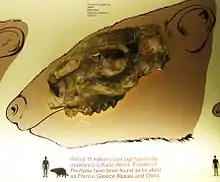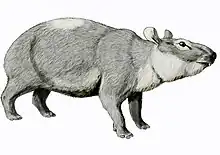Pliohyrax
Pliohyrax, is a genus of hyracoids (the cavy-like group of animals most closely related to elephants and manatees). It grew to sizes greatly exceeding those of any living hyrax, though it was by no means the largest member of this family.
| Pliohyrax Temporal range: | |
|---|---|
 | |
| Pliohyrax graecus | |
| Scientific classification | |
| Domain: | Eukaryota |
| Kingdom: | Animalia |
| Phylum: | Chordata |
| Class: | Mammalia |
| Order: | Hyracoidea |
| Family: | †Pliohyracidae |
| Subfamily: | †Pliohyracinae |
| Genus: | †Pliohyrax Osborn, 1899 |
| Species | |
| Synonyms | |
| |
Fossils of this Miocene-Pliocene, scansorial herbivore have been found in Afghanistan, France, and Turkey.[4] In Spain, Pliohyrax graecus is among the large mammals species found in the Almenara site, deposited during the Messinian salinity crisis, together with Macaca sp., Bovidae indet., cf. Nyctereutes sp., and Felidae indet.[5]
References
- "Genus †Pliohyrax". The Taxonomicon. April 2012. Retrieved 25 August 2012.
- "Soblay, excavation from 1949: MN 10, France". The Taxonomicon. Archived from the original on 18 December 2012. Retrieved 25 August 2012.
- Pickford, M.; Senut, B. (2018). "Afrohyrax namibensis (Hyracoidea, Mammalia) from the Early Miocene of Elisabethfeld and Fiskus, Sperrgebiet, Namibia" (PDF). Communications of the Geological Survey of Namibia. 18: 93–112.
- "Pliohyrax". Paleobiology Database. Retrieved 25 August 2012.
- Agustí, Jordi; Garcés, Miguel; Krijgsman, Wout (2006). "Evidence for African–Iberian exchanges during the Messinian in the Spanish mammalian record" (PDF). Palaeogeography, Palaeoclimatology, Palaeoecology. 238 (1–4): 5–14. Bibcode:2006PPP...238....5A. doi:10.1016/j.palaeo.2006.03.013.
This article is issued from Wikipedia. The text is licensed under Creative Commons - Attribution - Sharealike. Additional terms may apply for the media files.

